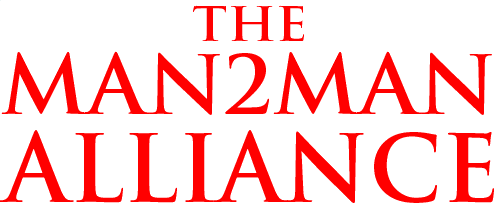


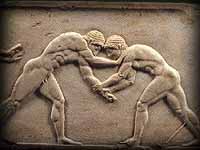

T I M E L I N E
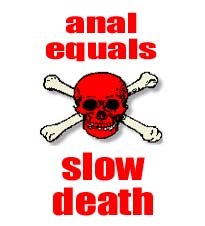





T I M E L I N E

TIMELINE
10-19-2006
1981 -- The first cases of what will come to be known as AIDS, clustered among five gay men in California, are reported in Morbidity and Mortality Weekly Reports.
1981 -- Dr. Alvin Friedman-Kien recommends that gay men stop having sex, or use condoms consistently until the cause of the new disease is found.
Larry Kramer, founder of Gay Men's Health Crisis, asks GMHC board members to endorse those views.
They refuse, and Kramer is accused of homophobia and anti-eroticism by gay playwright Robert Chesley, among others.
Chesley subsequently dies of AIDS.
Gabriel Rotello (see 1997 below) later characterizes this refusal as "The Lost Window of Opportunity."
1984 -- HIV is identified as the cause of AIDS.
1984 -- Anal sex is identified as the principal and major mode of HIV transmission among MSM.
Melbye M, Biggar RJ, Ebbesen P, et al. Seroepidemiology of HTLV-III antibody in Danish homosexual men: prevalence, transmission, and disease outcome. BMJ. 1984;289:573-575
Goudsmit J, Miedema F, Wijngaardendubois RJGJ, Roos M, Schellekens H, Coutinho RA, Vandernoorda J, Melief CJM. Serological evidence of transmission of HTLV in a Dutch homosexual male after anal intercourse with an AIDS patient. Aids. 101 - 109, 1984.
1985 -- The "condom code" -- not partner reduction and not avoidance of anal sex -- becomes the core American MSM HIV prevention strategy.
1985 - 1991 -- MSM in Holland are called upon to refrain from anal sex.
MSM HIV prevalence falls dramatically.
This strategy is rejected by gay leaders in the US.
[Source: Rotello, Plume: 1998, p 101 -- see the ADDENDUM to this Timeline for more information.]
1986 -- Anal sex is again identified as the principal and major mode of HIV transmission among MSM.
Schechter MT, Boyko WJ, Douglas B, et al. The Vancouver Lymphadenopathy-AIDS Study: 6. HIV seroconversion in a cohort of homosexual men. CMAJ. 1986;135:1355-1360.
1987 -- Anal sex is twice more identified as the principal and major mode of HIV transmission among MSM.
Darrow WW, Echenberg DF, Jaffe HW, et al. Risk factors for human immunodeficiency virus (HIV) infection in homosexual men. Am J Public Health. 1987;77:479-483.
van Griensven GJ, Tielman RA, Goudsmit J, et al. Risk factors and prevalence of HIV antibodies in homosexual men in the Netherlands. Am J Epidemiol. 1987;125:1048-1057
1987 -- Dutch researchers conclude that men who avoid anal sex and instead use "manual sexual techniques" do not contract HIV, even if they have multiple sexual partners:
As part of the prospective AIDS study in Amsterdam, blood samples were collected from 741 healthy homosexual men with multiple sexual partners, between October 1984 and May 1985. Samples were analyzed for the presence of antibodies to the human immunodeficiency virus (anti-HIV). Anti-HIV was demonstrated in 233 (31%) of the respondents. Seropositive respondents engaged in anal receptive sexual techniques with more sexual partners than did seronegative respondents, whereas seronegatives engaged in manual sexual techniques with more sexual partners than did seropositives. As far as it was possible to control for the interrelations between the measured variables, a direct relation with anti-HIV was established. This leads to the conclusion that when the number of sexual partners is considered a risk factor for HIV, a clear distinction should be made between the sexual techniques practiced with these partners. Two other risk factors for the presence of anti-HIV were the use of cannabis and of nitrite.
van Griensven GJP, Tielman RAP, Goudsmit J, et al. Risk Factors and Prevalence of HIV Antibodies in Homosexual Men in the Netherlands. Am J Epidemiol. 1987;125:1048-1057.
1988 -- Anal sex is again identified as the principal and major mode of HIV transmission among MSM.
Coates RA, Calzavara LM, Read SE, et al. Risk factors for HIV infection in male sexual contacts of men with AIDS or an AIDS-related condition. Am J Epidemiol. 1988;128:729-739.
1989 -- Dutch researchers publish again about the dangers of "anogenital intercourse" and the value of moving MSM away from anal:
The decline in transmission of HIV in thc AIDS cohort from 1985 onwards was probably a result of the decrease in sexual activity in the studied population and more specifically the decrease in the number of partners with whom anogenital intercourse was performed.
And, they add:
From 1984 onwards preventive activities were undertaken among homosexual men in The Netherlands to try to avoid the spread of AIDS such as that seen in the United States. There is little doubt that this influenced the sexual behaviour of homosexual men, which in turn reduced the transmission of HIV.
van Griensven, GJP, Devroome, EMM., Goudsmit, J, Coutinho, RA. Changes in sexual behaviour and the fall in incidence of HIV infection among homosexual men. BMJ. 1989;298:218 - 221.
1992 -- Anal sex is again identified as the principal and major mode of HIV transmission among MSM.
Seage GRR, Mayer KH, Horsburgh CRJ, et al. The relation between nitrite inhalants, unprotected receptive anal intercourse, and the risk of human immunodeficiency virus infection. Am J Epidemiol. 1992;135:1-11.
1993 -- Thompson reports condom failure rates in MSM anal sex of 4.7% to 8%.
Thompson, JLP. Estimated condom failure and frequency of condom use among gay men. Am J Public Health. 1993; 83:10.
1995 -- Anal sex is again identified as the principal and major mode of HIV transmission among MSM.
Ostrow DG, DiFranceisco WJ, Chmiel JS, et al. A case-control study of human immunodeficiency virus type 1 seroconversion and risk-related behaviors in the Chicago MACS/CCS Cohort, 1984-1992. Multicenter AIDS Cohort Study. Coping and Change Study. Am J Epidemiol. 1995; 142:875-883.
1995 -- A prospective study of condom use in Baltimore finds no differences in STI infection rates among those who reported using condoms 100 percent of the time versus zero percent of the time.
Zenilman, JM, Weisman, CS, Rompalo, AM, Ellish, N, Upchurch, DM, Hook, EW, et al. (1995). Condom use to prevent incident STDs: The validity of self-reported condom use. Sexually Transmitted Diseases, 22, 15-21.
1996 -- Anal sex is again identified as the principal and major mode of HIV transmission among MSM.
Buchbinder SP, Douglas JMJ, McKirnan DJ, et al. Feasibility of human immunodeficiency virus vaccine trials in homosexual men in the United States: risk behavior, seroincidence, and willingness to participate. J Infect Dis. 1996;174:954-961.
1997 -- Openly gay journalist Gabriel Rotello publishes Sexual Ecology: AIDS and the Destiny of Gay Men; Rotello describes how the combination of anal sex and promiscuity which erupted in the 1970s led to the MSM AIDS epidemic.
And how after the appearance of AIDS, gay community leaders refused to consider measures which would have decreased the prevalence of either anal or promiscuity.
Rotello is heavily, indeed stridently, criticized in the gay community for expressing his views.
1999 -- Anal sex is again identified as the principal and major mode of HIV transmission among MSM.
Vittinghoff E, Douglas J, Judson F, et al. Per-contact risk of human immunodeficiency virus transmission between male sexual partners. Am J Epidemiol. 1999;150:306-311.
1999 -- Veteran gay activist Bill Weintraub publishes Hyacinthine Love, his first article critical of what he calls "the cultural tyranny of anal sex" within the gay community.
Weintraub is attacked and condemned.
2000 -- Weintraub publishes his second article, Frot: the Next Sexual Revolution, calling for a rejection of anal sex by MSM and an exploration of non-anal alternatives.
Weintraub is attacked and condemned.
2000-2001 -- Weintraub publishes three more times about the role of anal sex and MSM promiscuity in the ongoing MSM HIV and other STD epidemics, and is attacked and condemned.
2001 -- African-American journalist and community activist Chuck Tarver publishes Missed Opportunity, about the failure of gay leaders to consider non-anal alternatives.
2002 -- Medical anthropologist Daniel Halperin presents a poster at Barcelona noting that women are 10 to 20 times more likely to contract HIV via anal sex than via vaginal sex.
Halperin, DT, Shiboski, SC, Palefsky, JM, and Padian, N. (2002) High level of HIV infection from anal intercourse: a neglected risk factor in heterosexual AIDS prevention. Poster presentation at the 2002 XIV International AIDS Conference in Barcelona
2003 -- Lousie Hogarth produces the documentary film The Gift, which examines the lives of gay men who seek infection with HIV through unprotected receptive anal sex with an infected partner -- "barebacking and bugchasing."
Although both phenomena are well known in the gay community, Walter Armstrong, editor of POZ, the nation's leading monthly magazine for those living with HIV, accuses Hogarth of "demonizing" gay men.
It should be noted that POZ strongly supported barebacking activist Stephen Gendin, a friend and business associate of POZ founder Sean Strub's, until Gendin's death from AIDS in 1999.
2003 -- Dr Edward C Green publishes an op-ed in the New York Times titled A Plan as Simple as ABC, detailing the success of primary behavior change in reducing HIV prevalence in Uganda.
2003 -- The Cochrane Institute publishes findings showing a 20% condom failure rate among serodiscordant heterosexual couples practicing *vaginal* sex:
Condom effectiveness in reducing heterosexual HIV transmission (Cochrane Review) Weller S, Davis, K.
The Cochrane Library, Issue 1, 2003. Oxford: Update Software Ltd.
Because the anus is neither self-lubricating nor as elastic as the vagina, it can be assumed that condom failure rates are higher in anal sex.
2003 -- UK AIDS specialist John Richens points to the disinhibiting effect of condoms and condom campaigns as a major factor in MSM HIV infection.
Richens, J., Imrie, J., & Weiss, H. (2003). Sex and death: why does HIV continue to spread when so many people know about the risks? J. of R. Statist Soc A 2003;166, 207-215.
2003 -- Bill Weintraub publishes another article, Rethinking Gay Sex, which again urges gay and bi men to move away from anal sex and towards safer non-anal alternatives.
Weintraub is again attacked and condemned.
2003 -- African-American journalist and community activist Chuck Tarver publishes Fighting the Conformity That Kills, which again calls for MSM to look at non-anal alternatives.
Tarver formulates an MSM version of ABC, the indigenous African program which has been so successful in reducing HIV prevalence in Uganda:
Avoid anal, Be faithful, use a Condom if you won't do the first two.
Phill Wilson, director of the Black AIDS Institute, refuses to discuss ABC and non-anal alternatives with Tarver.
2004 -- In a speech in New York City, Larry Kramer ascribes responsibility for the ongoing epidemic to gay men:
From the very first moment we were told in 1981 that the suspected cause was a virus, gay men have refused to accept our responsibility for choosing not to listen, and, starting in 1984, when we were told
it definitely was a virus, this behavior turned murderous. Make
whatever excuses you can to carry on living in your state of denial but this is the fact of the matter. I wish we could understand and take some responsibility for the fact that for some 30 years we have been murdering each other with great facility and that down deep inside of us, we knew what we were doing.
2005 -- Norman Hearst publishes perhaps the first controlled community trial demonstrating that "disinhibition" or risk compensation leads condom users to take more risks and to thereby increase risk of HIV infection.
Kajubi P, Kamya M, Kamya S, Chen S, McFarlandW, Hearst N. Increasing condom use without reducing HIV risk: results of a controlled community trial in Uganda. J Acquir Immune Defic Syndr 2005;40:77-82
2005 -- In May, Buchbinder et alia publish an important new study of MSM HIV risk, which shows little difference in risk between anal sex with a condom or without a condom.
They note:
Many studies have demonstrated that receptive anal sex is most strongly associated with prevalent and incident HIV infection in MSM and carries the highest per-contact risk of acquiring HIV. This study found that that URA [unprotected receptive anal] with either HIV-positive or unknown serostatus partners explained one quarter of new infections in this cohort. Surprisingly, we also found an independent increase in the risk of HIV seroconversion among men reporting PRA [protected receptive anal] with an HIV-positive partner. This finding likely represents a combination of overreporting of condom use and unrecognized condom failure by the receptive partner. Condom failure rates are particularly increased among MSM who use condoms infrequently, substance users, and those failing to use appropriate lubricants.
Buchbinder et al conclude that
Having a large number of male sex partners, nitrite inhalant use, and engaging in receptive anal sex explained the majority of infections in this cohort and should be targeted in prevention strategies for MSM.
Buchbinder et al. Sexual Risk, Nitrite Inhalant Use, and Lack of Circumcision Associated With HIV Seroconversion in Men Who Have Sex With Men in the United States. J Acquir Immune Defic Syndr Volume 39, Number 1, May 1 2005.
2005 -- On its website, the US Food and Drug Administration (FDA) warns of the dangers of anal sex even with a condom:
Are condoms strong enough for anal intercourse?
The Surgeon General has said, "Condoms provide some protection, but anal intercourse is simply too dangerous to practice."
Condoms may be more likely to break during anal intercourse than during other types of sex because of the greater amount of friction and other stresses involved.
Even if the condom doesn't break, anal intercourse is very risky because to can cause tissue in the rectum to tear and bleed. These tears allow disease germs to pass more easily from one partner to the other.
2005 -- Sifakis et alia report that HIV prevalence among American MSM has reached 25%; among Black American MSM, it's at 46%.
Sifakis, et al. (2005, June 24). Report of the National HIV Behavioral Surveillance System. Morbidity and Mortality Weekly Reports.
2006 -- Infectious disease expert Dr. Myron Cohen tells the President's Advisory Council on HIV / AIDS that
the efficiency of rectal intercourse changes everything because of the number of dendrite cells, receptors and trauma. So you can never overwhelm, you can't win against anal intercourse. ...
Anal intercourse is a really bad sexual practice for HIV transmission. It changes the equation. The efficiency [per contact risk] is probably one in ten or one in eight.
2006 -- UC Berkeley epidemiologist Dr. James Chin circulates chapters from his forthcoming book The AIDS Pandemic: the collision of epidemiology with political correctness :
How Effective Have HIV/AIDS Programs Been in Preventing HIV Transmission?
...
All infectious disease epidemics have similar stages: an early epidemic stage when R0 (the reproductive number of the infectious agent) is the highest; a slowing of epidemic spread when R0 begins to decrease; a peaking or leveling of epidemic transmission; and finally a decreasing phase when R0 is < 1. The impact of HIV prevention programs on any national prevalence trend is very difficult to measure since there are no valid control populations for comparison. If HIV was truly an infectious disease agent for which all or most persons in the population were at about equal risk, then significant differences in HIV prevalence in one population compared with another might be attributed to differences in prevention programs. If prevention programs are implemented when HIV epidemics are at or near their "natural" peaks, the subsequent decrease in prevalence might be incorrectly attributed to prevention programs. Yet most of the observed decrease might more likely be due to a saturation effect -- infection of most of the population with the highest risk behaviors. Thus, only a small proportion of the decrease in HIV prevalence might be due to prevention measures. The following section illustrates these problems in attributing reductions in observed HIV prevalence trends to prevention programs.
Decreasing HIV Incidence in an MSM Cohort
Figure 8.2 presents estimates of HIV prevalence and incidence based on point prevalence data from a cohort of MSM in San Francisco. Blood samples were collected from this MSM cohort because they were enrolled in a hepatitis B vaccine study. HIV prevalence rose from 1 percent in 1980 to 25 percent in 1982 to 65 percent in 1984. EPIMODEL was used to fit a prevalence curve to the three HIV prevalence data points and to calculate the annual HIV incidence needed to generate the "fitted" prevalence curve. According to this modeling of the HIV epidemic in this MSM cohort, annual HIV incidence peaked in 1983 at over 20 percent and then decreased sharply and dropped to about 5 percent by 1985.
The prevalence curve suggests that by 1983, about half of the MSM cohort, most likely the half with the highest sexual risk behaviors were infected with HIV. After 1983, HIV incidence fell sharply because the remaining half of the cohort probably had less risky behaviors and/or there was some overall reduction in sexual risk behaviors as a result of increasing reports of deaths attributed to this "emerging" disease. It should be noted that funding of State HIV/AIDS prevention programs was not started until after 1985.
2006 -- While American and other Western AIDS Service Organizations call for more condom campaigns, MSM HIV prevalence continues to rise.
Australia reports a 40% increase.
New York City reports a 40% increase.
In Los Angeles, MSM account for 75% of all HIV infections.
2006 -- At the Toronto International AIDS Conference, University of Pittsburgh researcher Ron Stall predicts that at present levels of incidence, "Fifty-eight percent of gay 20-year-olds in the Western world will be HIV-positive by the time they are 60."
New York City researchers agree, says the Gay City News, noting a disturbing trend:
...new HIV diagnoses increased among all gay and bisexual men under 30 from 2001 to 2004, while new diagnoses among such men over 30 declined.
"Among young, black MSM under 30 there is an increase," Torian said. "There is an increase among young, Hispanic MSM and among young, white MSM."
This could mean that all the gay and bisexual men over 30 who might be infected have been infected -- that the group is saturated -- and the virus is now spreading in a group where there are uninfected bodies.
Addendum: The Dutch Experiment.
Rotello, Plume: 1998, p 101:
Rotello cites as his source for this information King:
King, Edward. Safety in Numbers: Safer Sex and Gay Men. Routledge, 1993, p 46:
"The Netherlands provides a case-study of a country in which gay men were actively discouraged from using condoms for anal sex, in favor of giving up fucking altogether. ... It seems clear that in Holland, use of condoms played at most a small role in stopping the spread of HIV among gay men."
Rotello continues:
Nonetheless, this approach was never seriously considered by gay AIDS groups in the United States. Anal sex had come to be seen as an essential -- possibly the essential -- expression of homosexual intimacy by the 1980s.
Rotello adds that anyone criticizing anal would be deemed homophobic.
Rotello also points out that gay organizations refused to attack the ethic of multipartnerism.
Which begs the question: Is it homophobic to be critical of multipartnerism?
Are men in monogamous relationships homophobes?
Bill Weintraub
© All material Copyright 2006-2008 by Bill Weintraub. All rights reserved.
Add a reply to this discussion
Back to Personal Stories
AND
Warriors Speak is presented by The Man2Man Alliance, an organization of men into
Frot
To learn more about Frot, ck out What's Hot About Frot
Or visit our FAQs page.
The other approach [to prevention] ... would have urged men to refrain from anal sex altogether in favor of things like oral sex and noninsertive activities like masturbation. Such a policy was followed in Holland until 1991. Men were encouraged to give up anal sex completely, and many apparently did. Cohort studies of Dutch gay men reported that the practice of anal sex declined dramatically from 1984 to 1985. Since the level of HIV prevlalence in these cohorts remained lower than in most American cities -- the rate of new infections actually reached zero in one cohort in 1987 -- this advice may have been quite effective.

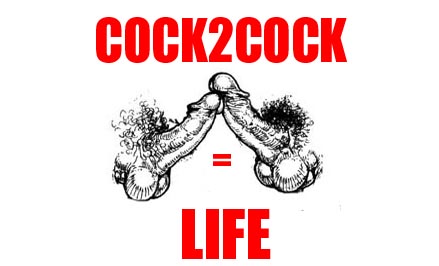
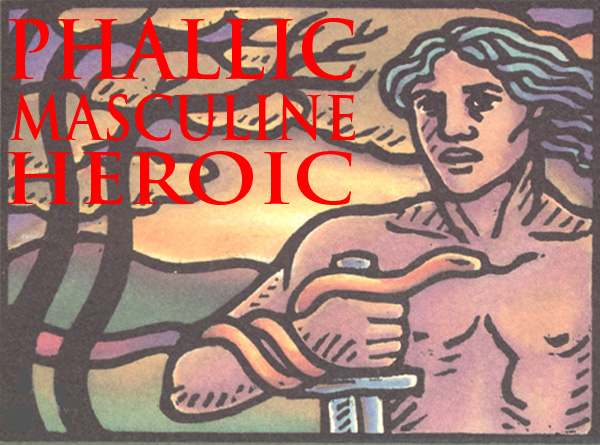







© All material on this site Copyright 2001 - 2010 by Bill Weintraub. All rights reserved.